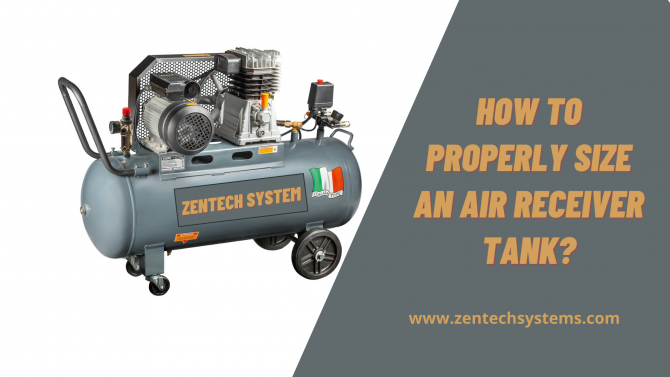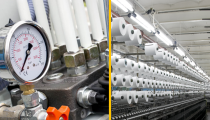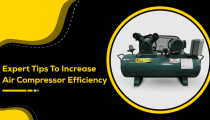Compressed air is a useful ingredient in many industries, useful…

How To Properly Size An Air Receiver Tank?
From ensuring secure temporary storage of compressed air to stabilizing demand fluctuations, air receiver tanks add to the overall efficiency of air compressor systems in a big way. However, in order to get optimal value from an air receiver, buyers have to make sure that its sizing is correct, and in sync with the air compressor it is connected to. Using any random air receiver vessel – without considering its size & operations – can cause a myriad of issues, right from operational glitches, to sub-par compressed air storage. We will here give you some handy pointers for sizing air receiver tanks properly though the internet.
Why Is It Important To Size An Air Receiver Tank?
The main purpose of using receiver tanks in air compressors is to minimise pulsations and ensure storage of compressed air. Unless an air receiver tank is sized properly, the time taken to refill it can be unnecessarily high – and system interruptions can crop up as well. The top air compressor suppliers have air receivers of different sizes (from the 5-gallon model to the much larger tank varieties). The key lies in selecting the one that would meet the requirements of the underlying application.
For basic compressed air systems, users can follow CFM requirements to calculate the size of the air receiver tank. The calculation steps are as follows:
- Select the tool that requires the highest CFM (at the given PSI).
- Multiply 1.25 or 1.5 to that CFM requirement.
- Round up the result to the nearest gallon size.
However, for more complicated and advanced compressed air systems, the sizing calculations have to be very precise and exact. This, in turn, ensures optimal performance of the entire system.
Air Receiver Tank Size Should Depend On The Required Discharge Pressure Of The Compressor
An air receiver vessel is used to serve as a buffer system between the changing compressed air demand (and resultant pressure fluctuations) and the air compressor. Buyers need to carefully estimate the difference between the compressor discharge pressure and the end-use pressure. As a rule of thumb, the higher this difference figure is, the lower will be the requisite size of the receiver tank.
The air receiver tank size has to be such that there is room for the tank pressure to go down by a certain amount (say, 10-15 PSIG) before the pressure requirement reaches the minimum level. If this is not possible (i.e., when the requirement and delivery of compressed air are equal), the air receiver tank cannot store additional output, and hence, fails to act as a buffer system. As such, it is extremely important to factor in the pressure differential (or pressure band) while sizing the air receiver.
The Capacity Of The Air Receiver Has To Be Considered
In general, using air compressors at 100% capacity utilization is not recommended – since that can cause energy expenses to rise, while there are also chances of the system getting damaged. Users need to go for air receiver tanks that can store more air than required, so that there is always some backup during peak demand levels.
To determine the requisite capacity of the receiver vessel, it is important to calculate the compressed air demand of all the applications that are simultaneously used. Based on this, an ‘utilization factor’ has to be calculated – to find out the ideal size of the air receiver tanks. The entire capacity of the receiver should not be used up to meet the compressed air requirement of the underlying applications.
Check The Time Required To Supply The Requisite Volume Of Air
Given the fact that the air demand levels keep fluctuating, it is of utmost importance that the receiver tank size has the capability to cater to these sudden demand changes. In other words, the receiver tank should double up as an emergency air reservoir in the system. To ensure this, the time required for an air receiver to provide the required volume of compressed air has to be tested.
While estimating the time needed for compressed air supply, users need to make sure that there is no significant fall in the air pressure during the process. If any such fall happens, there can be operational problems – and the overall viability & utility of the receiver tank is likely to be hampered. Air receivers that are not properly sized can cause system shortages too.
Air Receivers From Leading Compressed Air System Suppliers Minimise Pressure Fluctuations and Save Energy
The top manufacturers of air compressors, like Zentech Systems, make sure that the air receiver tanks they supply are rigorously tested and deliver optimal performance. Users need to select such tanks that would be able to streamline the compressed air production and delivery (including excess air volumes, as and when required). A good air receiver should be able to reduce the pressure fluctuations too – ruling out chances of excessive mechanical fatigue and wear & tear.
Since the best air receiver tanks have the capacity to significantly boost the efficiency of the air processing module, they help in cutting down on energy usage as well. When the tank does not lose too much of the excess air volume during operations, it remains functional for longer – and the overall lifespan of the compressed air system is enhanced.




